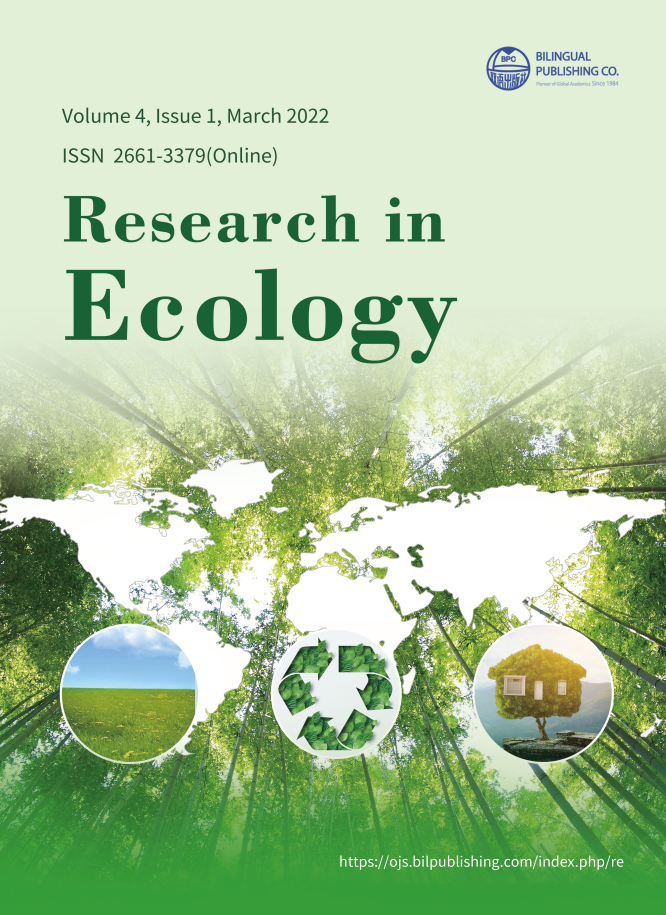
Evaluation of Plant Diversity for Sustainable and Inclusive Management in Rural Areas: A Case Study from Daressalam, Niger
DOI:
https://doi.org/10.30564/re.v4i1.4362Abstract
Plant biodiversity plays a major role for sustaining livelihood of rural population. However, unsustainable exploitation of woody plants for firewood in Niger is creating ecological challenges. This study aims to evaluate plant species composition, richness and equitability for sustainable and inclusive management in rural areas. Plot vegetation inventory method was employed. Forty-eight plots each measuring 2500 m2 were laid down systematically on a transect with the village at the centre. On each plot, plant species were identified and the number of each species counted. A total of twenty-five (25) plant species belonging to thirteen (13) families were identified among which Guiera senegalensis J. F. Gmel. accounted for 61%. The Shannon index was low (H’ = 0.45) as well as species equitability (E = 0.14). Species richness differed significantly (p < 0.000) with land use type with agroforestry parklands recording significantly higher species compared to plateaus. For effective plant biodiversity restoration and management, irrigated agroforestry is recommended to restore ecological balance and to assure and improve the quality of plant biodiversity in the study area.
Keywords:
Guiera senegalensis, Diversity indices, Sustainable and inclusive management, Land useReferences
[1] Bond, D.P.G., Wignall, P.B., 2008. The role of sea-level change and marine anoxia in the Frasnian-Famennian (Late Devonian) mass extinction. Palaeogeography, Palaeoclimatology, Palaeoecology. 263(3-4), 107-118. DOI: https://doi.org/10.1016/j.palaeo.2008.02.015.
[2] Gaston, K.J., 2000. Global patterns in biodiversity. Nature. 405(6783), 220-227. DOI: https://doi.org/10.1038/35012228.
[3] Adamou, R., Ibrahim, B., Bonkaney, A.L., et al., 2021. Niger - Land, climate, energy, agriculture and development: A study in the Sudano-Sahel Initiative for Regional Development, Jobs, and Food Security. ZEF Working Paper Series, ISSN 1864-6638, Center for Development Research, University of Bonn.
[4] Bhandari, R., Sessa, V., Adamou, R., 2020. Rural electrification in Africa - A willingness to pay assessment in Niger. Renewable Energy. 161, 20-29. DOI: https://doi.org/10.1016/j.renene.2020.06.151.
[5] Ibrahim, F., Ibrahim, B., 2020. Scheduling Supplementary Irrigation for Maize Production: Analysis of the Requirements for Climate Smart Farming for Rural Development. OALib. 07(11), 1-16. DOI: https://doi.org/10.4236/oalib.1106942.
[6] Moussa, S., Kyereh, B., Tougiani, A., et al., 2019. West African Sahelian cities as source of carbon stocks: Evidence from Niger. Sustainable Cities and Society. 50, 101653. DOI: https://doi.org/10.1016/j.scs.2019.101653.
[7] Ibrahim F., Inoussa, M.M., 2022. Assessment of Plant Species Diversity to Improve Agroforestry for food security in rural area. Master Thesis, University of Abdou Moumouni.
[8] Khan, M., Khan, S.M., Ilyas, M., et al., 2017. Plant species and communities assessment in interaction with edaphic and topographic factors; an ecological study of the mount Eelum District Swat, Pakistan. Saudi Journal of Biological Sciences. 24(4), 778-786. DOI: https://doi.org/10.1016/j.sjbs.2016.11.018.
[9] Thukral, A.K., 2017. A review on measurement of Alpha diversity in biology. Agricultural Research Journal. 54(1), 1. DOI: https://doi.org/10.5958/2395-146X.2017.00001.1.
[10] Hiernaux, P., Gérard, B., 1999. The influence of vegetation pattern on the productivity, diversity and stability of vegetation: The case of `brousse tigrée’ in the Sahel. Acta Oecologica. 20(3), 147-158. DOI: https://doi.org/10.1016/S1146-609X(99)80028-9.
[11] Zerbo, I., Bernhardt-Römermann, M., Ouédraogo, O., et al., 2016. Effects of Climate and Land Use on Herbaceous Species Richness and Vegetation Composition in West African Savanna Ecosystems. Journal of Botany. 2016, 1-11. DOI: https://doi.org/10.1155/2016/9523685.
[12] Wu, J.Sh., Zhang, X.Zh., Shen, Zh.X., et al., 2012. Species Richness and Diversity of Alpine Grasslands on the Northern Tibetan Plateau: Effects of Grazing Exclusion and Growing Season Precipitation. Journal of Resources and Ecology. 3(3), 236. DOI: https://doi.org/10.5814/j.issn.1674-764x.2012.03.006.
[13] Alignier, A., Solé-Senan, X.O., Robleño, I., et al., 2020. Configurational crop heterogeneity increases within-field plant diversity. Journal of Applied Ecology. 57(4), 654-663. DOI: https://doi.org/10.1111/1365-2664.13585.
[14] Ricciardi, V., Mehrabi, Z., Wittman, H., et al., 2021. Higher yields and more biodiversity on smaller farms. Nature Sustainability. 4(7), 651-657. DOI: https://doi.org/10.1038/s41893-021-00699-2.
[15] Basyuni, M., Jayusman, M., 2019. Plant species diversity and cluster analysis in difference logged-over peat swamp forests in Riau, Indonesia. IOP Conference Series: Earth and Environmental Science. 284(1), 012022. DOI: https://doi.org/10.1088/1755-1315/284/1/012022.
[16] Muhammad Salihu, A., Go, R., 2021. Noteworthy Threatened Plant Species in the Sahel Region, Nigeria. Endangered Plants, IntechOpen. DOI: https://doi.org/10.5772/intechopen.93975.
[17] Seghieri, J., Simier, M., 2002. Variations in phenology of a residual invasive shrub species in Sahelian fallow savannas, south-west Niger. Journal of Tropical Ecology. 18(6), 897-912. DOI: https://doi.org/10.1017/S0266467402002584.
Downloads
How to Cite
Issue
Article Type
License
Copyright © 2022 The author(s)

This is an open access article under the Creative Commons Attribution-NonCommercial 4.0 International (CC BY-NC 4.0) License.




 Inoussa Maman Maarouhi
Inoussa Maman Maarouhi






